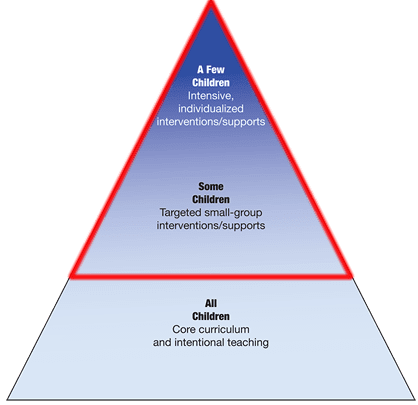
Social Emotional Development: Foundational Practices
Managing challenging behavior
Teachers can use techniques such as choice-making, ignoring, redirecting, and problem solving to address children’s challenging behavior. Choice-making involves giving children a couple of choices for alternative behavior. When a teacher ignores challenging behavior or withholds her attention from a child who exhibits challenging behavior, it’s likely that the problem behavior will stop. Redirecting involves helping children shift their focus to another task or activity. Problem solving means helping a child think about other ways of dealing with a situation and selecting better strategies to use the next time this happens. Occasionally it may be necessary for teachers to impose consequences when children do not follow classroom expectations. Consequences are most effective when they are connected to the behavior, not overly severe, and applied immediately and consistently (“If you take the trucks out of the block area, then we will have to put them away for a while.”). Teachers can also help children understand the effects that their behaviors have on others (“What happened when you took the toy from Tonya?”).
Video 7.12: Putting on a puppet show
After seeing some children arguing while putting on a puppet show, a teacher helps children use a technique called the Turtle Technique as a way to calm down and think of a better solution (running time: 1 min. 01 sec.).
View transcript
Teacher:
What’s going on guys? What are you doing with your puppets? Here Brandon, talk to me, talk to me. It’s ok. Are your puppets fighting each other? They are? Is that what we do? What can we do instead?
Brandon:
Go into his shell and go count to three.
Teacher:
Uh huh. Can you tell me how. Show me how. Show me what your puppet should do.
Brandon:
Tucks in his shell.
Teacher:
Ok. And then what?
Brandon:
Count 1 2 3.
Teacher:
Ok. And then come back out.
Brandon:
(unclear)
Teacher:
Ok so what could they do instead of fight?
Brandon:
They could play together.
Teacher:
Ok so how could they play together instead of fighting?
Brandon:
[Child demonstrates playing with the puppet]
Teacher:
Brandon! You thought like a turtle. Good job. I like the way you guys are thinking.
Video 7.13: Finding a resolution in the block area
A teacher uses a series of picture cards on the wall to help the children solve their conflict in the block area (running time: 1 min. 12 sec.).
View transcript
Child A:
Miss Stacy, he needs one at a time.
Teacher:
Well, what should we do about that?
Child B:
I need four.
Child A:
But you need one at a time.
Teacher:
Well you know what we have got to figure out a solution to this. What could we do, Jacob, Xavier, look up here. What could we do guys, come up here. Let’s figure it out. You have some blocks and you have some blocks, don’t you? Hmm. You guys want to trade? Would that work?
Child A:
I was telling him that I could trade.
Teacher:
You could maybe trade blocks with him?
Child A:
Yeah. After I’m done with this.
Teacher:
After you’re done with it. So you want him to wait his turn? Or maybe, I even see something else that would work out good.
Child A:
Wait his turn.
Teacher:
That’s a good one, that would work out. But there’s something else that might work out real good too. What about, what’s this one? Play…
Child B:
Together. Share. Teacher:And share. Would that work out? I think so. Where do you guys want to play and share?
Child A:
Play it over there.

